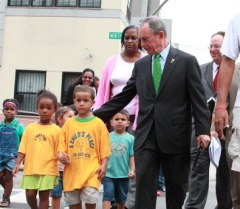
a major study and new policies that
will make it safer to walk in the Big Apple.
(Photo: NYC DOT)
Morning folks and welcome to the Roundup…
— The New York City DOT released a “landmark” study on walking that will help them push even farther, faster in re-claiming their streets for people (more details in NYC DOT press release).
— In St. Charles County, Missouri, the rural road bike ban is still being considered. The man who proposed the ban, Councilman Joe Brazil, has now issued two other options. He calls one of them a “fall-back ordinance” and it would require people riding on certain “dangerous stretches of highway” to wear “a blinking light, a flag and a mirror.” I’m not kidding.
— A traffic jam in China has lasted for nine days and “could last for weeks” (and apparently this isn’t the first time it’s happened). A CBC reports says that Chinese officials blame the backup on “insufficient traffic capacity.” Wow.
— Los Angeles Mayor Antonio Villaraigosa reports on his Bike Summit while another report says bike advocates in L.A. are “skeptical but hopeful“.
— Google gave a big “Thanks!” to everyone that offered suggestions on their “bike there” feature and they’ve announced that 80 more cities now have bike directions.
— Forbes delves into “the Great Train Robbery” and questions the wisdom of continued investment in commuter rail projects in Los Angeles. With bus services being cut around the country, rail projects are coming under more and more scrutiny.
— Up in Washington, they’re piloting a solar-powered LED-enhanced highway reflector that is 10-time brighter than standard reflectors. The reader that sent in the link wonders if these reflectors could improve the safety bike lanes/shoulders.
— Gene at the Biking Bis blog brings us news of a 10 mph bike speed limit on the Cedar River Trail in Renton, Washington. As our local off-highway trails continue to burst at the seams with users, we could see something similar in the future.
— The Oregonian notes how Portland’s Downtown Marketing Initiative — an effort to draw people downtown — is funded through parking meter fees. BTA staffer Susan Peithman wonders via Twitter whether the money could be used to encourage biking and transit improvements instead.


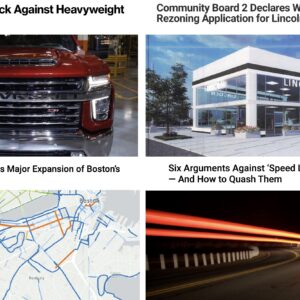
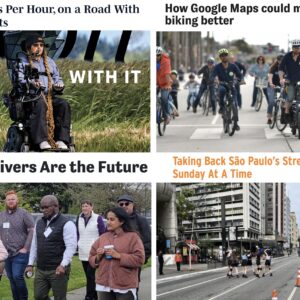
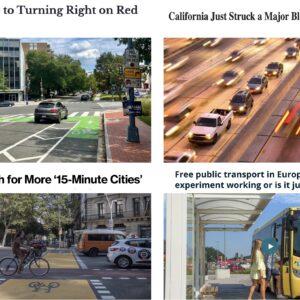
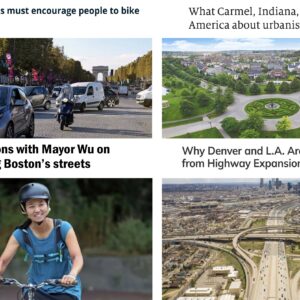
Thanks for reading.
BikePortland has served this community with independent community journalism since 2005. We rely on subscriptions from readers like you to survive. Your financial support is vital in keeping this valuable resource alive and well.
Please subscribe today to strengthen and expand our work.
the forbes piece was actually more interesting than i might have given it credit for. what they are saying is that the priority investment ought to be in commuter transit, bringing workers in from the burbs. discuss.
The blinky light thing reminds me of Salt Lake Cities response to having one of the highest pedestrian death rates in the nation. They put orange flags on sticks in little buckets on dangerous corners and you are supposed to waive the flag as you cross…
Regarding 10mph speed limits on “bike trails”–
Wow. Really? One incident of a bicyclist colliding with a pedestrian generates an outcry of such magnitude that the the speed limit is lowered by 33% in some sections, and riding is actually disallowed in other sections.
How many pedestrians do motor vehicle drivers have to run over before these kinds of regulations come to city streets? Where is the outcry when a pedestrian or cyclist (wait, never mind, let’s just consider pedestrians, since cyclists deserve to be run over…) is run over in a crosswalk (marked or unmarked) by some driver?
This sounds like an extreme over-reaction to some of the most misguided outrage ever. I still fail to understand why bikes and their riders are the targets of such disproportionate anger. What can I even compare it to?
i agree the cyclist has a problem in perception, both public and self. but this is what comes of treating MUPs as transit routes. if the street alternatives to the esplanade and springwater are not sufficient for bicyclists, something needs to be done on those streets.
Bjorn #2:
Ha! When I visited SLC last year for the first time I saw those and was pretty amused. I had a lot of fun waving them around as I crossed streets. 🙂
On the China traffic jam, here’s a link to another story that’s a little more complete than the one a link is provided for in the Monday Roundup:
China’s nine-day traffic jam stretches 100km/yahoo/afp
Lots of things that China is doing to get to the top of the world economic ladder are disturbing. This is one of them.
Susan Peithman’s Twitter comment didn’t show via the link. At any rate, it’s funny to try figure out Portland’s mindset associated with using parking meter revenue to draw people downtown.
Seems as though common logic would tell city leaders that having to pay a lot at the meter would tend tor drive people away from downtown rather than bringing them in. Is riding the bus or the light rail really that much better deal? It should be.
Oh, I see…the city’s just not charging enough to park on the street. That must be it. Charge more to park on the street, and then there will be more parking revenue from which to draw funds to create even bigger and better publicity campaigns to draw people downtown.
@El Biciclero — I think a good deal of what you call “disproportionate anger” toward bikes & their riders results from our perceptual biases related in Tom Vanderbilt’s Traffic and other sources. People tend to see bike riders as people; they tend not to see car drivers but cars (machines). Vanderbilt writes about one study in which, even when it was explicitly clear that the driver of a particular vehicle was a female, participants overwhelmingly used terms like “the car did…” or “the car should have…” rather than “she…”. It’s a lot easier to get angry at a person than a machine.
And in the case of MUPs, I think a lot of the anger has to do with expectations. We’ve been conditioned through decades of automotive hegemony to accept that crossing busy city streets inherently implies some level of risk. We may downplay that risk, just as people who drive on freeways downplay that risk, but that’s because we’ve internalized it. MUPs, on the other hand, are supposed to provide a respite from that risk. People use them for recreation and relaxation. A collision or a near-miss with someone speeding by on a bicycle seems that much worse in that context, because of the more intimate, relaxed setting and because of how we perceive bicyclists as people.
10 MPH?! Wanna’ kill both recreational and transportation cycling? Impose a ridiculous speed limit that makes riding inefficient. Nice job, Renton!
If the 10MPH limit were not bad enough, that trail also has a mile long stretch where riders must dismount and walk their bikes. WTF?!
It is interesting how quickly the respite from high volume, high speed, high intensity travel, that MUP’s are expected or hoped to provide, can degrade. Certain types of people apparently decide to just disregard the purpose for which the path was conceived and designated, replacing that with the service of their own personal interests instead.
Thanks to such people, we get things such as speed bumps, restrictions, and outright from the use of certain roadways and byways.
Correction:
“…and outright bans …”
I’d love to see speed limits imposed on the Esplanade and Waterfront pathways, particularly in the downtown core. I don’t think there’s anything unreasonable about calming bike speeds on shared use pathways.
That’s how Vancouver, BC does it, and their pathways are even wider than ours.
I agree with Steve B. Given current usage levels and current amounts of people going way faster than they should on multi-use paths, something’s got to give. Speed limit might not be a bad idea.
Problem is, since our bikeway network relies heavily on these routes, it will be quite an inconvenience to have to ride so slowly…. Which should put more pressure on the City to develop other bikeway connections.
RE: “Councilman Joe Brazil, has now issued two other options. He calls one of them a “fall-back ordinance” and it would require people riding on certain “dangerous stretches of highway” to wear “a blinking light, a flag and a mirror.”
Yep. Makes a whole lotta sense to me. Why stop at flag? Require bicyclists wear big, very busy, floppy dresses and Aretha Franklin hats too.
1) Motorists can’t say they didn’t see cyclists.
2) NOBODY wants to hit an old lady on a bike and make the six o’clock news.
3) Crotch won’t get heat stroke. Spandex…soooooo yesterday.
We clearly need bike-only lanes on busy mups and bridges. Hawthorne, in particular is a tragedy waiting to happen.
“Certain types of people apparently decide to just disregard…”
The problem is that in PDX these paths and mups were *sold* as commuting corridors and are heavily used as such. The problem is that bike commuting and wandering pedestrians just don’t mix. Seattle has bike only lanes on its heavily used mups.
I think a 10mph limit on the Hawthorne bridge is justified. At all times.
Getting buzzed without even the benefit of a bell is what these limits would try to address. It would needlessly lengthen the commute of most experienced commuters that do not cause problems on the trail. The speed limit may help from the pedestrians standpoint, but how would it be enforced?
Re the Renton, Washington, Cedar River Trail story; the 10mph speed limit is part of the response to the death of someone on that trail due a collision between a person on a bike and person on foot.
The speed limit was reduced as a matter of course, even though in that collision, it wasn’t certain that excess speed, or the greater speed represented by 15mph, as opposed to 10mph was specifically the cause of the collision. The general suggestion represented by the newly reduced speed limit, is that it was thought that trail users needed to be instructed to travel at a lower speed that would generally allow them more time to be aware of and respond safely to unexpected events occurring on the trail.
Here’s a link to a story about the person that was fatally injured:
story about fatality on Cedar River trail/By DEAN RADFORD
Renton Reporter Editor
Apr 19 2010
Both Bike Biz stories were fairly good. The writer for that blog also did a story with more details about the person that didn’t make it out of this collision:
walker dies after stepping in front of bicyclist
by Gene Bisbee at 09:02PM (PDT) on April 19, 2010
I recognize spare_wheel’s point raised in comment #14, that some trails are developed with the idea of their being commuter routes. Not all are. This one doesn’t seem to have been. From the King County/Cedar River Trail page:
“All non-motorized uses. Access to equestrians is restricted within Renton City limits.
Accessibility: Paved portions (such as at Liberty Park) are ADA accessible; unpaved sections are not. Disability access at Liberty Park.”
Reduced speeds alone aren’t enough to avoid collisions between people on these trails, especially when a great difference in speed amongst trail users is common. At least a little ironic it seems, at least to me, is that from several pictures of the Cedar River Trail that I’ve seen, it truly seems to be one that would support very fast bike speeds. Wide and smooth, it appears to be able to easily enable 20mph or faster.
On any trail though, that’s designated for mixed use, regardless what the speed limit is designated to be, people will have to train themselves to allow for slower trail users and the unexpected occurrence if they truly want the trail to be safe.
When I am driving a car and I want to maintain 35mph, I get on an arterial and avoid residential streets where only 20 or 25 is safe.
Similarly, when I want to ride a brisk pace, I stay the hell off mixed used paths and get on the street where it is generally safe to ride fast.
Unfortunately we now have to legislate common sense. And I suppose mixed use trails should never have been marketed as transportation corridors.
Speed limits are completely unenforcable since bicycles are not required to come with spedometers. Am I wrong? How can you get a ticket for going 15mph in a 10mph when you don’t have a spedometer?
Mike…Even without a speedometer, on a bike, it’s not that hard to get a sense of how fast 10mph is, especially with pedestrians walking(they travel roughly 3.5mph). The pedestrians provide a fairly easy gauge of speed for people on bikes; go twice as fast as they are and travel speed is 7mph.
I’m reasoning that the lower posted speed is a way to get people to lower their speed by means of approximation. People aren’t going to get citations for going 15mph in a 10mph; They’ll be getting citations for grossly disregarding the posted speed. In other words, traveling 18 mph or more.
Most people are likely to be aware on the bike, of the difference between 10mph and 18mph, because that’s a big difference. Even recognizing the difference between 10mph and 15mph should be fairly easy for most people.
I don’t mean to belabor mention of the lady that was killed up in Renton, Washington, but I do want to post one more link to a story that gives an in depth look at who this person was.
In my earlier comment, I avoided mentioning the lady’s age, knowing that its common for people to often reflexively dismiss other possible causes for collisions, besides old age, once they’ve become aware of the age of a person that may have somehow contributed to its cause.
Woman, 83, was vital, an athlete/Nicole Brodeur/Seattle Times staff columnist
While we’re at it, ban leashed dogs, rollerblades, skateboards, and strollers as these can possibly cause injuries to MUP users.
All MUP users must be equipped with a minimum of four flashing lights (red on back, white on front) AND a reflective vest or jacket visible from 100 yards away at all times.
All MUP users should be required to carry an air horn with a minimum audible blast of 90 decibels and must emit an audible signal whenever coming within 50 feet of another human being from any direction. Two blasts must be emitted if that human being appears to be under the age of 12 or over 60.
All MUP users regardless of activity must wear an ANSI/CSPC approved helmet at all times. The helmet must have an integrated strobe light at the crown that has a minimum visible range of greater than 800 meters. The light must be activated in any and all weather or light conditions.
All MUP users must stop at any trail intersection or blind turn, wait five seconds, emit two long and one short air horn blast, and perform a reasonable songbird call before proceeding forward.
Ridiculous? This is the brave new world of mediocrity and safety that we are hurtling towards. Strap on your helmet!